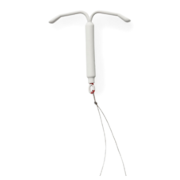Yup! You should be fine as long as you are careful not to pull on the IUD strings, which you shouldn’t need to worry about too much since the string of a tampon is outside of your vagina and the strings of your IUD should be up near your cervix. (If you find that your IUD strings are anywhere near your tampon strings, you should go see your health care provider because your IUD might not be in the correct place.)
- Birth control
- IUD
- FAQs
IUD

Can I use tampons with an IUD?
Want to learn more?
What do I do if my partner can feel the strings from my IUD?
The strings of the IUD usually get softer over time, but if they’re a problem for you or your partner, talk to a health care provider about adjusting them or cutting them shorter.
Want to learn more?
Which birth control method will help reduce my cramps?
Most people who use hormonal birth control—combination pill, patch, ring, implant, shot, and hormonal IUDs—will have less painful periods than those who don’t. This is because these methods of birth control make the lining of the uterus thinner. There’s less tissue in the uterus to shed (that’s what happens when you have your period), so periods are lighter. One special note on the implant and the shot: for some people, these methods cause more days of spotting or bleeding in between periods, but periods become lighter and less painful overall.
Does birth control cause blood clots?
Progestin-only methods like the implant, mini-pill, shot, and IUDs don’t increase your risk. If you’re worried about blood clots, we recommend talking to a health care provider about which birth control options are the safest for you.
Using a method of birth control with estrogen, like the combination pill, patch, and ring, increases your risk of forming a blood clot, but if you have no history of stroke, blood clots, or heart attack, and your family members have never experienced a blood clot, the risk is still quite low. If you have a history of these medical conditions, you have a higher risk of forming a new blood clot already so adding birth control with estrogen to the mix increases that risk and isn’t recommended.
Progestin-only methods like the implant, mini-pill, shot, and IUDs don’t increase your risk. If you’re worried about blood clots, we recommend talking to a health care provider about which birth control options are the safest for you.
Want to learn more?
Does the IUD increase the risk of pelvic inflammatory disease?
The 20 days after having an IUD inserted, you are past the highest risk time for developing PID from an STI you didn’t know you had during IUD insertion. After that time, PID happens at the same rate for people using IUDs as for those using other methods of birth control (other than condoms).
If you have a sexually transmitted infection (STI) at the time an IUD is placed in the uterus, there is at a higher risk of getting pelvic inflammatory disease (PID). This is why health care providers often check an STI test at the time they place the IUD (you don’t need to have the results before placing the IUD as long as there are no obvious signs of infection when they place the IUD). Having an STI is more likely if you are under age 26, have a new sexual partner, or have multiple partners—because all these groups are at higher risk of having an STI.
The 20 days after having an IUD inserted, you are past the highest risk time for developing PID from an STI you didn’t know you had during IUD insertion. After that time, PID happens at the same rate for people using IUDs as for those using other methods of birth control (other than condoms).
Want to learn more?
How soon does an IUD become effective after you get it?
The non-hormonal IUD and two of the brands of the hormonal IUD (Liletta and Mirena) are effective immediately after they’re inserted. They actually work as very effective emergency contraception, preventing pregnancy from sex you’ve had in the 5 days before they are placed! The other hormonal IUDs, Kyleena and Skyla, are effective immediately if you get it inserted within 7 days of the start of your period, you’re switching from another method of hormonal birth control that you’ve been using consistently, it’s been less than 7 days since a first or second-trimester pregnancy ended, or you gave birth in the last 21 days. Otherwise, it takes 7 days after the IUD is inserted to be effective at preventing pregnancy, so you’ll need to use a backup method, such as condoms or internal condoms if you have sex during that time.
Want to learn more?
What if I get an IUD, but want to get pregnant sooner than the 3 or 5 or 12 years that it's good for?
If you are using the non-hormonal IUD, it’s possible to get pregnant the same day it’s removed. If you are using a hormonal IUD, the hormones in the IUD are out of your body within a few days, and your body will return to whatever level of fertility is normal for you. It may be easier for some people to get pregnant than others.
This one is easy. If you’re ready to get pregnant (or just don’t want to use an IUD anymore), you can have your IUD removed at any time (even the day after you get it).
If you are using the non-hormonal IUD, it’s possible to get pregnant the same day it’s removed. If you are using a hormonal IUD, the hormones in the IUD are out of your body within a few days, and your body will return to whatever level of fertility is normal for you. It may be easier for some people to get pregnant than others.
Want to learn more?
Does hormonal birth control cause depression?
It can be complicated to tell exactly how hormonal birth control affects mood, but you’re the only one who truly knows how you feel. Everyone reacts to birth control differently, so if you feel your birth control might be contributing to depression, talk with your health care provider. It might be a matter of switching methods or deciding whether to avoid hormonal birth control altogether, or you may choose to wait it out since some negative side effects go away with time.
My doctor says they won’t give me an IUD because I’m too young and I haven’t had kids yet. What can I do?
Actually, experts agree it’s okay for people of all ages to use an IUD, and it’s also okay for use if you haven’t had kids. If your health care provider will not insert the IUD for you, try going to another health center in your area.
Want to learn more?
My IUD was expelled. Should I try again?
1. Haven’t been pregnant
2. Are younger than 20 years
3. Have a history of very heavy or very painful periods (though be mindful that these are reasons the hormonal IUD is recommended in the first place…)
4. Had the IUD put in right after giving birth or having an abortion after 14 weeks.
A partial expulsion may mean that the IUD was not quite in the right position: it may have been too low in the uterus and just worked its way out. This could be something that happened around the time of insertion, or may be related to the size, angle, or conditions like fibroids that can cause the uterus to have an irregular shape. For people who have an IUD expulsion, the chance of expelling a second IUD may be higher—in the 20% range (up to 30% in some studies).
If you want a second IUD after the first one came out, consider asking your health care provider about inserting the second IUD while using an ultrasound machine to make sure the IUD is inserted all the way to the top of the uterus where it belongs.
IUD expulsion (when part or all of the IUD comes out after it’s placed in the uterus) can occur in 2-10% of people in the first year after insertion. Expulsion can be more likely for people who:
1. Haven’t been pregnant
2. Are younger than 20 years
3. Have a history of very heavy or very painful periods (though be mindful that these are reasons the hormonal IUD is recommended in the first place…)
4. Had the IUD put in right after giving birth or having an abortion after 14 weeks.
A partial expulsion may mean that the IUD was not quite in the right position: it may have been too low in the uterus and just worked its way out. This could be something that happened around the time of insertion, or may be related to the size, angle, or conditions like fibroids that can cause the uterus to have an irregular shape. For people who have an IUD expulsion, the chance of expelling a second IUD may be higher—in the 20% range (up to 30% in some studies).
If you want a second IUD after the first one came out, consider asking your health care provider about inserting the second IUD while using an ultrasound machine to make sure the IUD is inserted all the way to the top of the uterus where it belongs.
Want to learn more?
What birth control methods are safe for people who just gave birth?
Birth control methods with no hormones, like the non-hormonal IUD, condoms, sterilization, lactational amenorrhea[RW5] , and hormonal methods that don’t contain estrogen—the shot, hormonal IUDs, the implant and the mini-pill—are all safe to use immediately after giving birth. Combination pills, the ring, and the patch, which contain estrogen, shouldn’t be used until three weeks after giving birth, since estrogen and being postpartum both increase the risk of blood clots.
I’m a smoker. What birth control options are best for me?
For most people, the risk of blood clots is low when they use the combination pill, the ring, and the patch. But smoking increases this risk. If you are over 35 and smoke 15 or more cigarettes a day, the combination pill, patch, and ring are not safe options for you. If you’re over 35 and you smoke less than 15 cigarettes a day, talk to your provider about whether these birth control methods are safe options for you.

Heat up your weekends with our best sex tips and so much more.